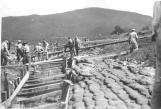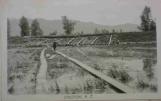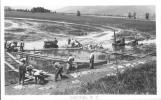15
"Lumber was pounded into the ground inside the dykes and held in place with pegs. Sandbags were stacked in rows within this structure to stop the dykes from sloughing. The sandbags would have been stacked about three, three-and-a-half feet deep. You can see the pegs at the right edge of the wall; they're standing straight up. This hasn't started to slough yet."- Bill Irvine
16
Sandbags being stacked in wooden frames along the inside of the dykes.1948
Wynndel, north of Creston, BC

17
"If it started to slough after the first stack of sandbags were put in place, more planks were laid perpendicular to the rows of sandbags, another wooden brace was pounded in and secured with pegs, and another stack of sandbags stacked inside that."- Bill Irvine
19
The seepage through and under the dykes turned the fields to mud and made the work much harder. To help solve this problem, says Bill Piper, "The cats would come by with the sloops, loaded with sandbags, snubbed on behind. They'd drop the sandbags in piles until they showed above the water, and lay planks across the top of the sandbag piles."20
Men passing sandbags to thestack on the right, along the inner side of the dykes.1948
Creston Valley, BC

21
Soon, a network of plank walkways stretched like ribbons from the dykes, and rows of men passed the sandbags along from the drop-off point to the stacks along the dykes.23
It was not possible for the little caterpillar tractors, pulling sled-like sloops full of sandbags, to come right alongside the dykes. As Bill Irvine remembers, "there was so much water seeping in that when the cats came by, you could feel the ground slipping. If they came too close, the dykes started shifting. The ground was that wet, and the dykes were wet, too."25
To make matters worse, burrowing animals such as muskrats had dug tunnels into the dykes, which the water could follow. Some of these burrows, were submerged, and showed up as turbulence in the river, like this one.Others came out on top of the dykes, creating geyser-like spouts of water. This, says Bob Rogers, was "what we called a boil, when the water just gushed up out of the ground. You'd put a ring of sandbags around it to try and create a back pressure. And as the water run dirt in there, you'd put another ring on it and another ring and another ring, like a big pyramid, and it just grew right out of proportion."




